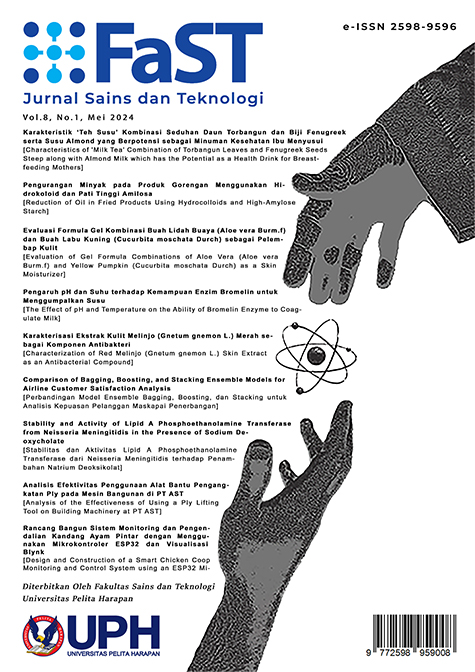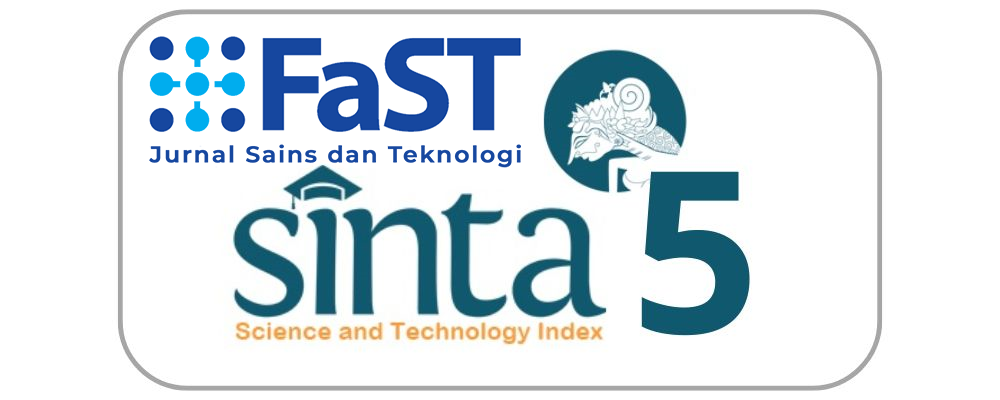KARAKTERISASI EKSTRAK KULIT MELINJO (Gnetum gnemon L.) MERAH SEBAGAI KOMPONEN ANTIBAKTERI [CHARACTERIZATION OF RED MELINJO (Gnetum gnemon L.) SKIN EXTRACT AS AN ANTIBACTERIAL COMPOUND]
DOI:
https://doi.org/10.19166/jstfast.v8i1.7598Keywords:
antimicrobial, bacterial, cell damage, melinjoAbstract
Melinjo peel is generally disposed, even though it contains bioactive compounds such as tannin, flavonoid and saponin, which can be used as antimicrobial compound. The purpose of this research was to analyze the antimicrobial activity of melinjo peel extract. The extraction of red melinjo peel was conducted by maceration method using ethyl acetate as solvent for 24 h at room temperature. The extract at concentration 4, 8, 12, and 16% (w/v) could not inhibit the growth of Rhizopus oligosporus ATCC 22959, whereas could inhibit the growth of Escherichia coli ATCC 8739, Bacillus cereus ATCC 10876, and Pseudomonas aeruginosa ATCC 9027. The Minimum Inhibitory Concentration (MIC) of the extract was ranged from 0.50-0.69%, while the Minimum Bactericidal Concentration (MBC) value was ranged from 2.00-2.76%. The phytochemical compounds that found in extract were alkaloids, saponin, phenolic, flavonoids and glycosides. The inhibitory capacity of the extract at selected concentration (12%) had a similar level as compared to 1000 ppm Colistin against E. coli and P. aeruginosa. The inhibition of extract increased at low pH (pH 4), while neutral pH decreased the inhibition of the extract. Heat treatment at 65oC for 30 minutes increased the antibacterial activity, whereas heat treatment at 75, 85, and 95oC decreased the antibacterial activity of the extract. Addition of salt and sugar at concentration 1-5% and 10-50%, respectively, increased the antibacterial activity of the extract. The extract could damage cell morphology and was confirmed by the presence of ions (Ca2+, K+, and Mg2+) outside of the cells.
Bahasa Indonesia Abstract:
Kulit melinjo umumnya dibuang, padahal mengandung komponen bioaktif seperti tanin, flavonoid, dan saponin, yang dapat dimanfaatkan sebagai komponen antimikroba. Tujuan penelitian ini karakterisasi komponen bioaktif ekstrak kulit melinjo merah sebagai antibakteri. Proses ekstraksi kulit melinjo merah dilakukan dengan metode maserasi menggunakan pelarut etil asetat selama 24 jam pada suhu ruang. Ekstrak etil asetat kulit melinjo merah pada konsentrasi 4, 8, 12, dan 16% (w/v) tidak dapat menghambat kapang R. oligosporus ATCC 22959, namun dapat menghambat bakteri E. coli ATCC 8739, B. cereus ATCC 10876, dan P. aeruginosa ATCC 9027. Nilai Minimum Inhibitory Concentration (MIC) dan Minimum Bactericidal Concentration (MBC) dari ekstrak terhadap ketiga bakteri uji berturut-turut adalah 0.50-0.69%, dan 2.00-2.76%. Komponen fitokimia yang terdapat pada ekstrak etil asetat terdiri dari alkaloid, saponin, fenolik, flavonoid, dan glikosida. Ekstrak etil asetat dengan konsentrasi terpilih (12%) memiliki diameter zona hambat hampir setara dengan antibiotik kolistin 1000 ppm terhadap bakteri E. coli dan P. aeruginosa. Ekstrak pada kondisi asam (pH 4) memiliki diameter zona hambat lebih besar dibandingkan pH netral (pH 7). Pemanasan ekstrak pada suhu 65oC selama 30 menit akan meningkatkan diameter zona hambat, dan menurun pada suhu pemanasan 75, 85, dan 95oC. Penambahan garam dan gula masing-masing pada konsentrasi 1-5% dan 10-50% akan meningkatkan diameter zona hambat ekstrak. Ekstrak dapat merusak morfologi ketiga bakteri uji, yang didukung dengan keluarnya ion-ion penyusun dinding sel (Ca2+, K+, dan Mg2+). Ekstrak etil asetat kulit melinjo merah memiliki komponen bioaktif yang mampu membunuh dan menghambat pertimbuhan mikroba uji.
References
Alakomi, H. L., Skytta, E., Saarela, M., Mattila-Sandholm, T., Latva-Kalla, K., & Helander, I. M. (2000). Lactic acid permeabilizes Gram-negative bacteria by disrupting the outer membran. Journal of Applied Environmental Microbiology, 66(5), 2001-2005. https://doi.org/10.1128/AEM.66.5.2001-2005.2000
Amalia, Dwiyanti, R. D., & Haitami. (2016). Daya hambat NaCl terhadap pertumbuhan Staphylococcus aureus. Medical Laboratory Technology Journal, 2(2), 42-45. https://doi.org/10.31964/mltj.v2i2.125
Ardiansyah. (2002). Kajian aktivitas antimikroba ekstrak daun beluntas (Plucea indica L.) [Master’s Thesis]. Institut Pertanian Bogor, Bogor, Indonesia.
Ardiansyah, Nuraida, L., & Andarwulan, N. (2003). Aktivitas antimikroba ekstrak daun beluntas (Plucea indica L.) dan stabilitas aktivitasnya pada berbagai konsentrasi garam dan tingkat pH. Jurnal Teknologi dan Industri Pangan, 14(2), 90-97.
Asmara, A. P. (2017). Uji fitokimia senyawa metabolit sekunder dalam ekstrak metanol bunga turi merah (Sesbania grandiflora L. Pers). Jurnal Al-Kimia, 5(1), 48-59. https://doi.org/10.24252/al-kimia.v5i1.2856
Baurain, D., Wilmotte, A., & Frere, J. (2016). Gram-negative bacteria: “inner” vs. “cytoplasmic” or “plasma membrane”: A question of clarity rather than vocabulary. Journal of Microbial and Biochemical Technology, 8(4), 325-326. https://doi.org/10.4172/1948-5948.1000305
Badan Pusat Statistik. (2015). Statistik Tanaman Buah-buahan dan Sayuran Tahunan. Badan Pusat Statistik, Jakarta.
Canzani, D., & Aldeek, F. (2017). Penicillin G’s function, metabolites, allergy, and resistance. Journal of Nutrition and Human Health, 1(1), 28-40. https://doi.org/10.35841/nutrition-human-health.1.1.28-40
Cepeda, G. N., Lisangan, M. M., & Silamba, I. (2015). Aktivitas antibakteri ekstrak kulit kayu akway (Drimys piperita Hook f.) terhadap bakteri patogen. Agritech, 35(2), 170-177. https://doi.org/10.22146/agritech.9403
Conly, J. M., & Johnston, B. L. (2006). Colistin: The phoenix arises. Canadian Journal of Infectious Diseases and Medical Microbiology, 17(5), 267-269. https://doi.org/10.1155/2006/901873
de Lira Mota, K. S., de Oliveira Pereira, F., de Oliveira, W. A., Lima, I. O., & de Oliveira Lima, E. (2012). Antifungal activity of Thymus vulgaris L. essential oil and its constituent phytochemicals against Rhizopus oryzae: Interaction with ergosterol. Molecules, 17(12), 14418-14433. https://doi.org/10.3390/molecules171214418
Dewi, C., Utami, R., & Parnanto, N. H. R. (2012). Aktivitas antioksidan dan antimikroba ekstrak melinjo (Gnetum gnemon L.). Jurnal Teknologi Hasil Pertanian, 5(2), 74-81.
Dowling, A., Dwyer, J. O., & Adley, C. C. (2017). Antibiotics: Mode of action and mechanisms of resistance. In A. Mendez-Vilaz (Ed.), Antimicrobial research: Novel bioknowledge and educational programs (pp. 536-545). Formatex Research Center.
Ergina, Nuryanti, S., & Pursitasari, I. D. (2014). Uji kualitatif senyawa metabolit sekunder pada daun palado (Agave angustifolia) yang diekstraksi dengan pelarut air dan etanol. Jurnal Akademika Kimia, 4(3), 165-172.
Gyawali, R., & Ibrahim, S. A. (2014). Natural products as antimicrobial agents. Food Control, 46, 412-429. https://doi.org/10.1016/j.foodcont.2014.05.047
Hendritomo, H. I. (2003). Perubahan mutu kecap skala industri rumah tangga selama tiga bulan. Jurnal Teknologi dan Industri Pangan, 14(3).
Hendriko, A., Parhusip, A. J. N., Juwono, A. L., Budiman, I., & Natalie, B. (2024). Mechanism and stability of antimicrobial activity of Zingiber cassumunar Roxb. rhizome extract against foodborne pathogenic microorganisms. Food Biophysics. https://doi.org/10.1007/s11483-024-09841-x
Jahan, N., Islam, M. A. Alam, F., Gan, S. H., & Khalil, M. I. (2015). Prolonged heating of honey increases its antioxidant potential but decreases its antimicrobial activity. African Journal of Traditional, Complementary and Alternative Medicines, 12(4),134-144. https://doi.org/10.21010/ajtcam.v12i4.20
Kato, E., Tokunaga, Y., & Sakan, F. (2009). Stilbenoids isolated from the seeds of melinjo (Gnetum gnemon L.) and their biological activity. Journal of Agricultural and Food Chemistry, 57(6), 2544-2549. https://doi.org/10.1021/jf803077p
Kim, J. Y., Lee, Y. C., & Kim, K. S. (2002). Effect of heat treatments on the antimicrobial activities of garlic (Allium sativum). Journal of Microbiology and Biotechnology, 12(2), 331-335.
Misna, & Diana, K. (2016). Aktivitas antibakteri ekstrak kulit bawang merah (Allium cepa L.) terhadap bakteri Staphylococcus aureus. Jurnal Farmasi Galenika, 2(2), 138-144. https://doi.org/10.22487/j24428744.2016.v2.i2.5990
Naufalin, R., & Herastuti, S. R. (2013). Microcapsule application of kecombrang flower extract: Effect of concentration, type of fraction, pH of medium and NaCl on microbiological properties of minced beef. Animal Production, 15(1), 8-14.
Naufalin, R., & Rukmini, H. S. (2017). Antibacterial activity of kecombrang flower extract (Nicolaia speciosa) microencapsulation with food additive materials formulation. IOP Conference Series: Earth and Environmental Science, 102, 012035. https://doi.org/10.1088/1755-1315/102/1/012035
Octavia, J. (2010). Analisis kerusakan sel mikroba patogen akibat aktivtias antimikroba ekstrak biji dan kulit melinjo (Gnetum gnemon L.) [Bachelor’s Thesis]. Universitas Pelita Harapan, Karawaci, Indonesia.
Parhusip, A. J. N., & Sitanggang, A. B. (2011). Antimicrobial activity of melinjo seed and peel extract (Gnetum gnemon) against selected pathogenic bacteria. Jurnal Mikrobiologi Indonesia, 5(3), 103-112. https://doi.org/10.5454/mi.5.3.2
Ray, B. (2001). Fundamental food microbiology. (2nd ed.). CRC Press.
Settharaksa, S., Jongjareonrak, A., Hmadhlu, P., Chansuwan, W., & Siripongvutikorn, S. (2012). Flavonoid, phenolic contents and antioxidant properties of thai hot curry paste extract and its ingredients as affected of pH, solvent types and high temperature. International Food Research Journal, 19(4), 1581-1587.
Siregar, T. M., Cornelia, M. Ermiziar, T., & Saragih, R. (2009). Studi kandungan karotenoid, vitamin C dan aktivitas antioksidan kulit melinjo (Gnetum gnemon L.). Prosiding Seminar Nasional PATPI, Jakata, Indonesia.
Syafitri, N. E., Bintang, M., & Falah, S. (2014). Kandungan fitokimia, total fenol, dan total flavonoid ekstrak buah harendong (Melastoma affine D. Don). Current Biochemistry, 1(3), 105-115.
Tamilselvi, N., Krishnamoorthy, P., Dhamotharan, R., Arumugam, P., & Sagadevan, E. (2012). Analysis of total phenols, total tannins and screening of phytocomponents in Indigofera aspalathoides (Shivanar Vembu) Vahl EX DC. Journal of Chemical and Pharmaceutical Research, 4(6), 3259-3262.
Widyasanti, A., Priantiwi, A. M., & Rohdiana, D. (2016). Aktivitas antibakteri Bacillus cereus dan Shigella dysenteriae ekstrak teh putih dalam variasi jenis pelarut. Jurnal Penelitian Teh dan Kina, 1(19), 41-56.
Widyawati, P. S., Budianta, T. D. W., Kusuma, F. A., & Wijaya, E. L. (2014). Difference of solvent polarity to phytochemical content and antioxidant activity of Pluchea indicia Less leaves extracts. International Journal of Pharmacognosy and Phytochemical Research, 6(4), 850-855. https://doi.org/10.22302/pptk.jur.jptk.v19i1.81
Yanuhar, U. (2016). Mikroalga laut Nannochloropsis oculata. UB Press.
Downloads
Published
Issue
Section
License
“Authors who publish with this journal agree to the following terms:
1) Authors retain copyright and grant the journal right of first publication with the work simultaneously licensed under a Creative Commons Attribution License (CC-BY-SA 4.0) that allows others to share the work with an acknowledgement of the work's authorship and initial publication in this journal.
2) Authors are able to enter into separate, additional contractual arrangements for the non-exclusive distribution of the journal's published version of the work (e.g., post it to an institutional repository or publish it in a book), with an acknowledgement of its initial publication in this journal.
3) Authors are permitted and encouraged to post their work online (e.g., in institutional repositories or on their website). The final published PDF should be used and bibliographic details that credit the publication in this journal should be included.”



